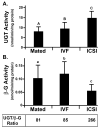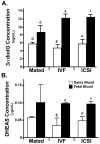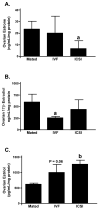Assisted reproduction technologies impair placental steroid metabolism
- PMID: 19406239
- PMCID: PMC2702461
- DOI: 10.1016/j.jsbmb.2009.04.005
Assisted reproduction technologies impair placental steroid metabolism
Abstract
The placenta plays a vital role in pregnancy by facilitating steroid passage from maternal to fetal circulation and/or direct production of hormones. Using a murine model, we demonstrated the differences in placental steroid metabolism between pregnancies conceived naturally and with assisted reproduction technologies (ART): in vitro fertilization (IVF) and intracytoplasmic sperm injection (ICSI). While the ovarian steroid production was similar (estrone, 17beta-estradiol) or higher (estriol) in ART pregnancies compared to mating, the levels of placental estriol were significantly lower in ART group. Placentas from ART had significantly higher activities of the steroid metabolizing enzymes UDP-glucuronosyltransferase (UGT) and sulfotransferase (SULT), which in ICSI were also coupled with decreased activity of the steroid regenerating enzymes beta-glucuronidase (beta-G) and aryl sulfatase (AS). Levels of steroid metabolites androstane-3alpha-17beta-diol glucuronide and dehydroepiandrosterone sulfate were higher in fetal compared to maternal blood in ART, but not in mating. This study demonstrates that in murine ART pregnancies, higher metabolism and clearance of steroids by the placenta may seriously affect the passage of essential hormones to the fetus. If a similar phenomenon exists in humans, this could provide a plausible explanation for obstetric and neonatal complications associated with ART, including the higher incidence of low birth weight babies.
Figures






Similar articles
-
Assisted reproduction technologies alter steroid delivery to the mouse fetus during pregnancy.J Steroid Biochem Mol Biol. 2011 Aug;126(1-2):26-34. doi: 10.1016/j.jsbmb.2010.12.012. Epub 2010 Dec 28. J Steroid Biochem Mol Biol. 2011. PMID: 21193037 Free PMC article.
-
Placental inflammation and oxidative stress in the mouse model of assisted reproduction.Placenta. 2011 Nov;32(11):852-8. doi: 10.1016/j.placenta.2011.08.003. Epub 2011 Sep 1. Placenta. 2011. PMID: 21889208 Free PMC article.
-
Blastomere removal from cleavage-stage mouse embryos alters steroid metabolism during pregnancy.Biol Reprod. 2012 Jul 5;87(1):4, 1-9. doi: 10.1095/biolreprod.111.097444. Print 2012 Jul. Biol Reprod. 2012. PMID: 22517623 Free PMC article.
-
[Endocrino-pharmacological study of reproduction: Role and biosynthesis of steroid hormones in the feto-placental unit].Nihon Yakurigaku Zasshi. 1981 Mar;77(3):231-44. Nihon Yakurigaku Zasshi. 1981. PMID: 6762983 Review. Japanese.
-
Offspring physiology following the use of IVM, IVF and ICSI: a systematic review and meta-analysis of animal studies.Hum Reprod Update. 2023 May 2;29(3):272-290. doi: 10.1093/humupd/dmac043. Hum Reprod Update. 2023. PMID: 36611003 Free PMC article.
Cited by
-
Placental development during early pregnancy in sheep: effects of embryo origin on vascularization.Reproduction. 2014 Apr 8;147(5):639-48. doi: 10.1530/REP-13-0663. Print 2014 May. Reproduction. 2014. PMID: 24472816 Free PMC article.
-
In vitro fertilization alters phospholipid profiles in mouse placenta.J Assist Reprod Genet. 2019 Mar;36(3):557-567. doi: 10.1007/s10815-018-1387-y. Epub 2019 Jan 4. J Assist Reprod Genet. 2019. PMID: 30610659 Free PMC article.
-
Effect of the method of conception and embryo transfer procedure on mid-gestation placenta and fetal development in an IVF mouse model.Hum Reprod. 2010 Aug;25(8):2039-46. doi: 10.1093/humrep/deq165. Epub 2010 Jun 24. Hum Reprod. 2010. PMID: 20576634 Free PMC article.
-
Assisted reproduction technologies alter steroid delivery to the mouse fetus during pregnancy.J Steroid Biochem Mol Biol. 2011 Aug;126(1-2):26-34. doi: 10.1016/j.jsbmb.2010.12.012. Epub 2010 Dec 28. J Steroid Biochem Mol Biol. 2011. PMID: 21193037 Free PMC article.
-
Paternal epigenetic influences on placental health and their impacts on offspring development and disease.Front Genet. 2022 Nov 18;13:1068408. doi: 10.3389/fgene.2022.1068408. eCollection 2022. Front Genet. 2022. PMID: 36468017 Free PMC article. Review.
References
-
- US, D.o.H.a.H. Services. Assisted Reproduction Technologies Success Rates. National Summaries and Fertility clinic reports 2003. 2006
-
- Wright VC, Schieve LA, Reynolds MA, Jeng G. Assisted reproductive technology surveillance--United States, 2000. MMWR Surveill Summ. 2003;52:1–16. - PubMed
-
- Reddy UM, Wapner RJ, Rebar RW, Tasca RJ. Infertility, assisted reproductive technology, and adverse pregnancy outcomes: executive summary of a National Institute of Child Health and Human Development workshop. Obstet Gynecol. 2007;109:967–977. - PubMed
-
- Allen VM, Wilson RD, Cheung A. Pregnancy outcomes after assisted reproductive technology. J Obstet Gynaecol Can. 2006;28:220–250. - PubMed
-
- Buckett WM, Chian RC, Holzer H, Dean N, Usher R, Tan SL. Obstetric outcomes and congenital abnormalities after in vitro maturation, in vitro fertilization, and intracytoplasmic sperm injection. Obstet Gynecol. 2007;110:885–891. - PubMed
Publication types
MeSH terms
Substances
Grants and funding
LinkOut - more resources
Full Text Sources
Medical
Research Materials

